Tags: VE apiedit |
No edit summary Tag: sourceedit |
||
| (2 intermediate revisions by 2 users not shown) | |||
| Line 15: | Line 15: | ||
Replicators (along with [[transporter]]s and [[force field]]s) were one of the technologies used in [[holodeck]]s and [[holosuite]]s. ({{VOY|The Cloud|Twisted|Dark Frontier|Pathfinder|Human Error}}) |
Replicators (along with [[transporter]]s and [[force field]]s) were one of the technologies used in [[holodeck]]s and [[holosuite]]s. ({{VOY|The Cloud|Twisted|Dark Frontier|Pathfinder|Human Error}}) |
||
| − | Some alien replication technology has been used to create organic material, such as when the [[D'Arsay archive]] created living snakes. The "Allegiance" aliens were also able to create living things, as in the case of Picard's imposter, in which the replicators were even able to recreate the dendritic connections where memory is stored. ({{TNG|Masks|Allegiance}}) |
+ | Some alien replication technology has been used to create organic material, such as when the [[D'Arsay archive]] created living snakes. The "Allegiance" aliens were also able to create living things, as in the case of Picard's imposter, in which the replicators were even able to recreate the dendritic connections where memory is stored. ({{TNG|Masks|Allegiance}}) |
| + | |||
| + | While only a [[Genitronic replicator]] could fully replicate actual organs for use in medical transplants ({{TNG|Ethics}}), by [[2371]], standard Starfleet replicator technology was theoretically capable of creating artificial substitutes for natural organs for use in medical transplants. However, this required the system to have some understanding of the organs required; for example, it was impossible to use a replicator to create a set of [[Talaxian]] lungs as Talaxian physiology included a complex series of neural links between the lungs and the rest of the body that replicators were unable to duplicate exactly ({{VOY|Phage}}). |
||
==History and notable uses== |
==History and notable uses== |
||
| Line 35: | Line 37: | ||
On the [[Promenade]] of the Federation [[space station]] [[Deep Space 9]], the [[Replimat]] provided a laid back location for inhabitants to enjoy a meal or beverage courtesy of a bank of replicators located along one of its walls. ({{DS9|Emissary}}) |
On the [[Promenade]] of the Federation [[space station]] [[Deep Space 9]], the [[Replimat]] provided a laid back location for inhabitants to enjoy a meal or beverage courtesy of a bank of replicators located along one of its walls. ({{DS9|Emissary}}) |
||
| + | |||
| + | {{bginfo|The ubiquity of replicator technology by the late 24th century is likely the chief contributor to the development of the post-scarcity economy of the Federation.}} |
||
===Replicators in the Delta Quadrant=== |
===Replicators in the Delta Quadrant=== |
||
| Line 57: | Line 61: | ||
| ⚫ | |||
[[cs:Replikátor]] |
[[cs:Replikátor]] |
||
| Line 65: | Line 68: | ||
[[ja:レプリケーター]] |
[[ja:レプリケーター]] |
||
[[ru:Репликатор]] |
[[ru:Репликатор]] |
||
| ⚫ | |||
Revision as of 17:59, 18 April 2015
AT: "xx"
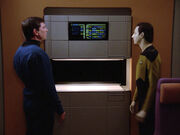
A food replicator aboard a Galaxy-class starship
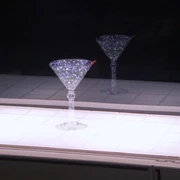
A replicated martini materializes
- Food slot redirects here, you may also be looking for a food synthesizer.
A replicator was a device that used transporter technology to dematerialize quantities of matter and then rematerialize that matter in another form. It was also capable of inverting its function, thus disposing of leftovers and dishes and storing the bulk material again. (TNG: "Lonely Among Us"; DS9: "Hard Time", "The Ascent"; VOY: "Year of Hell", "Memorial")
Replicators were capable of producing something as fresh and tasty as non-replicated foodstuffs, inorganically materialized out of patterns used by the transporters. (TNG: "Lonely Among Us") Most people found replicated foods and drinks to taste exactly the same as "real" food, although some people claimed to be able to tell the difference. Furthermore, Federation replicators could be programmed to produce foodstuffs of acceptable "nutritional value". (TNG: "The Price", "Sins of the Father", "The Wounded", "Relics"; DS9: "In the Pale Moonlight", "You Are Cordially Invited")
In addition to foodstuffs, replicators could be used for replicating machine parts, clothing or other objects. Although clothing can be replicated for general wear, replicators will not allow non-Starfleet crew members to replicate official Starfleet uniforms. Industrial replicators could even be used to replicate heavier machine parts. (TNG: "The Game"; DS9: "For the Cause"; VOY: "Caretaker", "Phage")
Replicators aboard Starfleet vessels would not produce fatal poisons. (VOY: "Death Wish") Furthermore, replicators had biofilters which automatically screened out all contaminants. (DS9: "Babel")
On Starfleet installations and starships, if a person in custody is confined to quarters, it is standard policy to disable the replicators that the person has access to, in order to ensure that a weapon cannot be replicated. (DS9: "Inquisition"; VOY: "Counterpoint")
Replicators (along with transporters and force fields) were one of the technologies used in holodecks and holosuites. (VOY: "The Cloud", "Twisted", "Dark Frontier", "Pathfinder", "Human Error")
Some alien replication technology has been used to create organic material, such as when the D'Arsay archive created living snakes. The "Allegiance" aliens were also able to create living things, as in the case of Picard's imposter, in which the replicators were even able to recreate the dendritic connections where memory is stored. (TNG: "Masks", "Allegiance")
While only a Genitronic replicator could fully replicate actual organs for use in medical transplants (TNG: "Ethics"), by 2371, standard Starfleet replicator technology was theoretically capable of creating artificial substitutes for natural organs for use in medical transplants. However, this required the system to have some understanding of the organs required; for example, it was impossible to use a replicator to create a set of Talaxian lungs as Talaxian physiology included a complex series of neural links between the lungs and the rest of the body that replicators were unable to duplicate exactly (VOY: "Phage").
History and notable uses
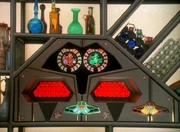
The replicators in Quark's Bar on Deep Space 9
One of the first replicators seen by Humans was the one seen by the crew of Enterprise when they had their ship repaired in the mysterious repair station. Until this time the most comparable technology aboard 22nd century starships were protein resequencers, which had limited capabilities compared to later technologies. (ENT: "Dead Stop"; ENT: "Fight or Flight", "Oasis")
In the 23rd century, the United Federation of Planets had not yet perfected replicator technology for ships but replicators already existed in industrial sites. Replicator technology was, however, in use by The Assigners, and the Beta 5 computer utilized replicator technology to manufacture several false identity cards for use by Gary Seven. (TOS: "Assignment: Earth"). Starships of this time period were equipped with food synthesizers. This was a step forward, but did not achieve the quality and sophistication of the 24th century replicator. Replicator technology was not yet employed on starships as late as 2293. (TOS: "The Naked Time", "The Trouble with Tribbles"; VOY: "Flashback")
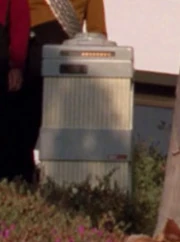
A portable matter replicator
24th-century Federation starships were commonly equipped with replicators because they allowed for a wide variety of foods and beverages to be served to crew members and also allow for replication of other objects. The selection was limited only by the software and the number of options that had been programmed. (TNG: "The Neutral Zone", "The Defector", "Sins of the Father", "All Good Things..."; DS9: "Trials and Tribble-ations"; VOY: "Caretaker", "Phage", "Twisted")
Captain Jean-Luc Picard beamed down to Delta Rana IV with a portable matter replicator for the Uxbridges in 2366. (TNG: "The Survivors")
As of 2367, Galaxy-class starships were equipped with a replicating center containing several replicator terminals resembling miniature transporter pads at which crew members could order items. Lieutenant Worf and Lieutenant Commander Data shopped the USS Enterprise-D's replicating center for a wedding present for Miles and Keiko O'Brien. (TNG: "Data's Day")
The replicator played a key role in spreading the Ktarian game around the USS Enterprise-D in 2368. (TNG: "The Game")
On the Promenade of the Federation space station Deep Space 9, the Replimat provided a laid back location for inhabitants to enjoy a meal or beverage courtesy of a bank of replicators located along one of its walls. (DS9: "Emissary")
Replicators in the Delta Quadrant
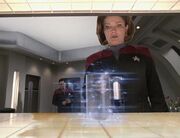
A replicator malfunctions and creates a mug - after the coffee
After the USS Voyager was pulled to the Delta Quadrant in 2371, an energy crisis occurred several weeks into the journey back to the Alpha Quadrant, and Janeway ordered replicator usage to be rationed in order to conserve power for other key systems. These replicator rations became a type of currency amongst its crew. (VOY: "The Cloud")
Later that year, it became very clear that replicator technology was unknown to the indigenous people of the region around the Ocampan homeworld. The Kazon, in particular, repeatedly tried to obtain this technology, as did other races. Captain Janeway feared that if this technology were acquired by a civilization before they were ready, disastrous consequences could ensue. For this reason, and because of the Prime Directive, Janeway refused to give up this technology at any price. (VOY: "State of Flux") By 2377, however, the crew of Voyager had shared replicators to help people feed and clothe themselves a number of times. (VOY: "Flesh and Blood")
In 2374 in the alternate timeline known as the Year of Hell, the replicator system on Voyager was heavily damaged by attacks from Krenim warships, forcing the crew to go to emergency rations. (VOY: "Year of Hell")
In 2377, Voyager acquired technology from a race within The Void that had joined The Alliance which tripled the ship's replicator efficiency. (VOY: "The Void")
